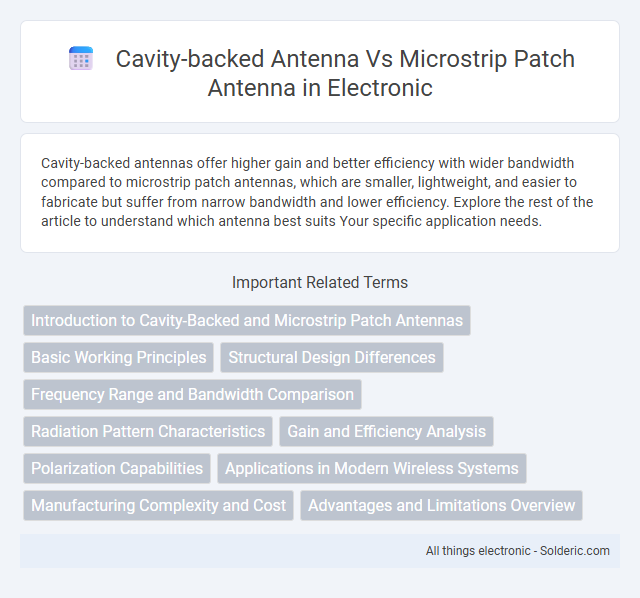Cavity-backed antennas offer higher gain and better efficiency with wider bandwidth compared to microstrip patch antennas, which are smaller, lightweight, and easier to fabricate but suffer from narrow bandwidth and lower efficiency. Explore the rest of the article to understand which antenna best suits Your specific application needs.
Comparison Table
| Feature | Cavity-Backed Antenna | Microstrip Patch Antenna |
|---|---|---|
| Structure | Metallic cavity with radiating element | Thin dielectric substrate with metallic patch |
| Bandwidth | Wide bandwidth (up to several GHz) | Narrow bandwidth (typically 1-5%) |
| Gain | High gain (10-15 dBi) | Moderate gain (5-8 dBi) |
| Size | Larger, bulky design | Compact and low-profile |
| Polarization | Usually linear or circular | Linear polarization |
| Efficiency | High efficiency (>80%) | Moderate efficiency (~60-70%) |
| Manufacturing Complexity | Complex, requires precise metal machining | Simple, suitable for PCB fabrication |
| Applications | Radar, satellite, high-power systems | Wireless communication, IoT, portable devices |
Introduction to Cavity-Backed and Microstrip Patch Antennas
Cavity-backed antennas feature a resonant cavity that enhances bandwidth and gain by reducing surface wave losses, making them ideal for high-frequency applications. Microstrip patch antennas consist of a radiating patch on a grounded substrate, known for their low profile, ease of fabrication, and compatibility with planar integrated circuits. While cavity-backed designs offer superior performance in terms of efficiency and power handling, microstrip patches excel in compactness and cost-effectiveness for wireless communication systems.
Basic Working Principles
A cavity-backed antenna operates by using a metallic cavity to enhance radiation efficiency and bandwidth through resonant modes within the cavity, which reflects energy and reduces surface wave losses. A microstrip patch antenna consists of a radiating patch on a grounded dielectric substrate, where the patch resonates at specific frequencies to emit electromagnetic waves primarily due to fringing fields at the patch edges. Both antennas rely on resonance phenomena, but cavity-backed antennas achieve higher gain and broader bandwidth compared to microstrip patch antennas, which are simpler and more compact for integration in planar circuits.
Structural Design Differences
Cavity-backed antennas feature a metal cavity which enhances bandwidth and gain by reducing surface wave losses, while microstrip patch antennas use a thin dielectric substrate with a metallic patch, resulting in a compact and low-profile design. The cavity-backed structure is bulkier and more complex, providing improved radiation efficiency, whereas the microstrip patch antenna offers ease of fabrication and integration into planar circuits. Your choice depends on application requirements where space constraints favor microstrip patches, but high-performance needs might lean towards cavity-backed designs.
Frequency Range and Bandwidth Comparison
Cavity-backed antennas generally offer broader bandwidth and better performance across higher frequency ranges compared to microstrip patch antennas, which typically operate efficiently within narrow frequency bands. The cavity structure minimizes losses and supports modes that increase bandwidth, making these antennas suitable for applications requiring wideband capabilities such as radar and satellite communications. Your choice depends on frequency requirements and bandwidth needs, with cavity-backed antennas preferred for high-frequency, wideband uses and microstrip patches favored for compact, narrowband designs.
Radiation Pattern Characteristics
Cavity-backed antennas exhibit highly directional radiation patterns with increased gain and reduced back lobes due to the cavity's ability to suppress surface waves, making them ideal for applications requiring focused energy. Microstrip patch antennas generally produce broader beamwidths with moderate directivity and more significant side lobes, suitable for wide coverage areas. The cavity-backed design enhances front-to-back ratio and polarization purity compared to typical microstrip patches.
Gain and Efficiency Analysis
Cavity-backed antennas generally exhibit higher gain and improved efficiency compared to microstrip patch antennas due to their superior impedance matching and reduced surface wave losses. The enclosed cavity structure minimizes radiation loss, enhancing directivity and overall radiation efficiency, often achieving gains above 10 dBi. In contrast, microstrip patch antennas typically suffer from lower gain, usually around 6-9 dBi, and reduced efficiency caused by dielectric and conductor losses inherent to their planar design.
Polarization Capabilities
Cavity-backed antennas offer superior polarization diversity, typically supporting linear, circular, and elliptical polarizations with high purity due to their enclosed structure that minimizes cross-polarization. Microstrip patch antennas mainly provide linear polarization, though designs can achieve circular polarization using truncated corners or dual-feed techniques, but often with narrower bandwidth and lower polarization purity. The choice between these antenna types depends on the required polarization versatility and performance in complex electromagnetic environments.
Applications in Modern Wireless Systems
Cavity-backed antennas excel in high-frequency radar, satellite communication, and millimeter-wave applications due to their superior gain, bandwidth, and reduced surface wave losses, making them ideal for demanding wireless systems. Microstrip patch antennas dominate smartphone, Wi-Fi, and IoT devices because of their compact size, ease of integration, and low manufacturing cost, supporting modern wireless network proliferation. Your choice between these antenna types directly impacts system performance factors like efficiency, frequency range, and integration complexity in contemporary communication technologies.
Manufacturing Complexity and Cost
Cavity-backed antennas typically involve more complex manufacturing processes, including precise metal cavity fabrication and assembly, which significantly increases production costs. Microstrip patch antennas are easier and cheaper to manufacture using standard printed circuit board techniques, making them suitable for mass production and cost-sensitive applications. Your choice depends on balancing budget constraints with performance requirements, as microstrip patches offer a cost-effective solution while cavity-backed antennas provide superior performance at a higher manufacturing expense.
Advantages and Limitations Overview
Cavity-backed antennas offer high gain, wide bandwidth, and excellent power handling capabilities, making them ideal for high-frequency and high-power applications, but they tend to be bulky and complex to manufacture. Microstrip patch antennas are compact, lightweight, and easy to fabricate on printed circuit boards, providing low-profile solutions suitable for mobile and portable devices, yet they suffer from narrow bandwidth and lower gain compared to cavity-backed designs. Your choice depends on balancing performance requirements with size and manufacturing constraints for your specific application.
cavity-backed antenna vs microstrip patch antenna Infographic

 solderic.com
solderic.com